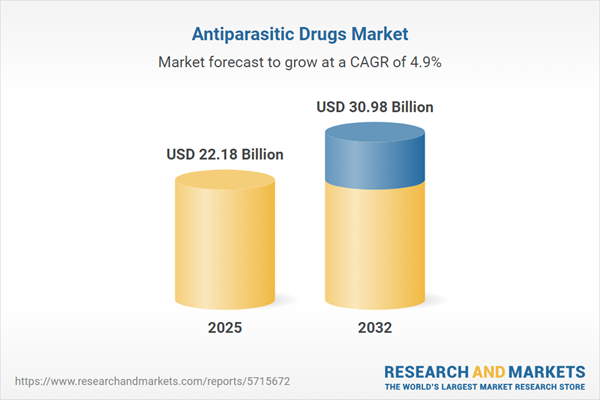Speak directly to the analyst to clarify any post sales queries you may have.
The Antiparasitic Drugs Market is rapidly advancing as animal health and agricultural stakeholders navigate regulatory shifts, increasing resistance, and innovation in therapeutic solutions. Strategic responses to evolving market dynamics are critical for senior leaders seeking sustained growth and effective risk management in veterinary pharmaceuticals.
Market Snapshot: Growth and Market Drivers in Antiparasitic Drugs
The antiparasitic drugs market grew from USD 21.12 billion in 2024 to USD 22.18 billion in 2025 and is poised for continued growth at a CAGR of 4.90%, projecting revenues of USD 30.98 billion by 2032. This trajectory is underpinned by robust demand across livestock, companion animals, and aquaculture, heightened emphasis on animal food safety, and a response to complex global regulatory requirements. Investments in molecular pharmacology and digital innovation drive precision therapies and improved lifecycle management, delivering value for both established leaders and emerging players in the sector.
Scope & Segmentation
This analysis delivers a comprehensive breakdown of the antiparasitic drugs market, covering vital product and application dimensions:
- Drug Classes: Amino-Acetonitrile (e.g., Monepantel); Benzimidazoles (Albendazole, Fenbendazole, Mebendazole, Oxibendazole, Thiabendazole); Macrocyclic Lactones (Abamectin, Doramectin, Eprinomectin, Ivermectin); Spiroindoles (Derquantel).
- Veterinary Applications: Aquaculture (Fish, Shrimp); Companion Animals (Canine, Feline); Livestock (Cattle, Poultry, Swine).
- Regional Coverage: Americas (North America, Latin America), Europe Middle East & Africa (Europe, Middle East, Africa), Asia-Pacific.
- Companies Covered: Zoetis Inc.; Merck & Co., Inc.; Boehringer Ingelheim International GmbH; Elanco Animal Health Incorporated; Bayer AG; Ceva Santé Animale S.A.; Virbac S.A.; Dechra Pharmaceuticals PLC; Vetoquinol S.A.; Norbrook Laboratories Limited.
This segmentation enables readers to compare diverse treatment, regional, and supply chain considerations in the context of regulatory and technology advances.
Key Takeaways for Decision-Makers
- Innovation in antiparasitic drug mechanisms is essential to address resistance challenges and regulatory demands for safety and environmental compliance.
- Collaboration between academic centers, contract research organizations, and industry leaders accelerates time-to-market and pipeline diversity, enhancing development flexibility and real-world relevance.
- Evolving digital technologies, including artificial intelligence and advanced analytics, enable more efficient drug discovery, post-launch monitoring, and tailored solutions adaptive to changing resistance profiles.
- Direct-to-consumer and telemedicine platforms are expanding access, particularly for aquaculture and remote livestock, while value-based offerings are aligning product delivery with economic and environmental goals.
- Regional strategy customization is fundamental; the Americas, EMEA, and Asia-Pacific regions each present unique regulatory environments, market needs, and growth opportunities, demanding targeted product and supply chain approaches.
Tariff Impact: Strategic Response to U.S. Policy Changes
Recent tariffs introduced by the United States in 2025 have changed cost structures across the global antiparasitic drug supply chain. Added duties on imported active pharmaceutical ingredients have driven companies to diversify sourcing strategies, initiate bilateral supplier agreements, and accelerate onshore manufacturing. While these strategies mitigate some risk, they also present trade-offs between cost efficiency and lead times. The resulting pressure on pricing structures has prompted greater adoption of generics and bundled value-based solutions, as stakeholders seek to manage increased operational and capital demands.
Methodology & Data Sources
This report uses a rigorous combination of secondary sources—including regulatory data, academic publications, and company filings—and primary research through interviews with industry stakeholders and market experts. Quantitative surveys and data triangulation ensure accuracy. Findings were validated by a workshop of senior experts, and all analysis underwent strict quality control for reliability and practical relevance.
Why This Report Matters
- Enables senior decision-makers to benchmark strategic initiatives and operational priorities in a rapidly evolving antiparasitic drugs landscape.
- Empowers pharmaceutical leaders with actionable segmentation, competitive intelligence, and regulatory context for effective investment and partnership planning.
- Provides clarity on the impact of technology, policy, and regional trends, facilitating informed resource allocation and sustainability alignment.
Conclusion
The antiparasitic drugs market is shaped by evolving scientific, regulatory, and supply chain trends, requiring multifaceted strategic responses. Senior executives equipped with the insights from this report are positioned to drive sustainable growth and navigate future complexity with confidence.
Additional Product Information:
- Purchase of this report includes 1 year online access with quarterly updates.
- This report can be updated on request. Please contact our Customer Experience team using the Ask a Question widget on our website.
Table of Contents
3. Executive Summary
4. Market Overview
7. Cumulative Impact of Artificial Intelligence 2025
Companies Mentioned
The companies profiled in this Antiparasitic Drugs market report include:- Zoetis Inc.
- Merck & Co., Inc.
- Boehringer Ingelheim International GmbH
- Elanco Animal Health Incorporated
- Bayer AG
- Ceva Santé Animale S.A.
- Virbac S.A.
- Dechra Pharmaceuticals PLC
- Vetoquinol S.A.
- Norbrook Laboratories Limited
Table Information
| Report Attribute | Details |
|---|---|
| No. of Pages | 190 |
| Published | October 2025 |
| Forecast Period | 2025 - 2032 |
| Estimated Market Value ( USD | $ 22.18 Billion |
| Forecasted Market Value ( USD | $ 30.98 Billion |
| Compound Annual Growth Rate | 4.9% |
| Regions Covered | Global |
| No. of Companies Mentioned | 11 |









